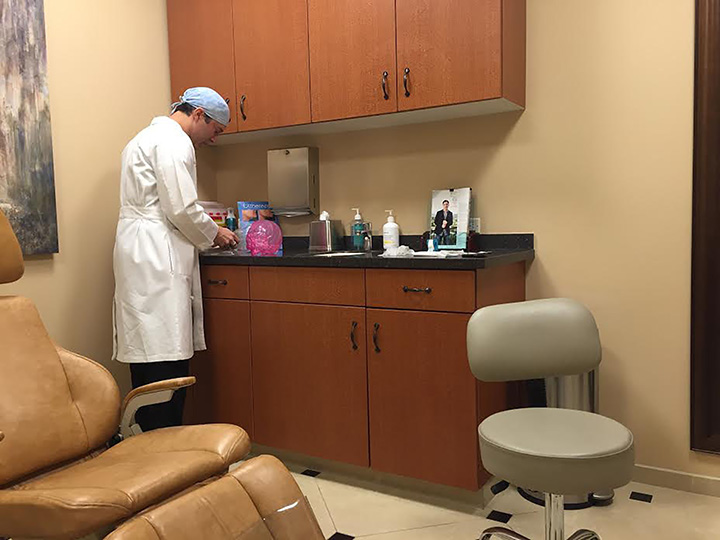
Dr. Pablo Prichard was on the floor at John C. Lincoln Medical Center when Jake Reynolds was rushed to the trauma center. (Photo by Zac Pacleb/Cronkite News)
The last thing Jake Reynolds remembers is chasing a frisbee through a bush at Sierra Verde Park in Glendale.
After that, he blacked out.
A car traveling 25 to 30 miles per hour struck Reynolds, then a junior at Mountain Ridge High School. Reynold’s head went through the windshield, decimating his face. He was rushed to HonorHealth John C. Lincoln Medical Center in Phoenix.
But Reynold’s luck turned after he arrived at the hospital. Dr. Pablo Prichard was working as the trauma surgeon on the floor.
After patching up the internal damage, Prichard used a high-definition CT scan to develop a 3-D printed implant to reconstruct Reynold’s face.
Today, Reynolds looks like any other 18-year-old high school senior.
3-D technology has not been used much at all in reconstructive facial surgery, Prichard said.
The U.S. Food and Drug Administration approved a 3-D printed facial implant in 2014, according to Medical Daily. But the popularity and use of it remained minimal, and surgeons are still experimenting with the technology.
The procedure
Doctors initially worried that the facial lacerations and damage to Reynold’s skull would lead to brain damage. After they ruled that out, the next step was reconstructing his facial structure.
Prichard described Reynolds’ injuries as “really devastating.” He said the bones in his face were “crushed to a pulp.”
Prichard had to reconstruct the muscles, nerve endings and even the salivary gland.
Reynolds said people tell him his injuries remind them of the character Harvey Dent in the movie “The Dark Knight.” Reynolds said he hasn’t looked at the pictures of his injuries and has no plans to do so.
“I refuse to see the ‘before’ pictures because I don’t want to see myself like that,” he said.
Generally, doctors would have used metal plates and screws to reconstruct Reynold’s face. But the bones did not have enough blood supply and essentially “died away,” Prichard said.
Because of that, Prichard decided to reconstruct Reynolds’ face utilizing the 3-D printing technology.
“The idea just came from the fact that we’ve used this technology before in the more common way as far as the skull defects and simpler objects,” Prichard said. “(It’s) basically kind of extending our previous experience in a more complicated way.”
Utilizing the CT scan, Prichard placed antibiotic bone cement to fill in the space where the bone had died to prevent scar tissue from building and the facial structure from collapsing.
He then sent detailed plans to a company to make the 3-D implant.
Although this is the first time Prichard used this technology to reconstruct someone’s face, Reynolds said he had complete faith in his surgeon.
“I totally trust Dr. Prichard,” Reynolds said. “I’ve seen from past three previous surgeries before that he’s great and awesome. He’s made it better than I believe anyone else could. So I was like, ‘Yeah, let’s go for it.’ I know he wouldn’t do something that he thought was iffy on me.
“I’m not his guinea pig, so I trust him.”
Moving forward
It’s been a year since the accident, and Reynolds looks like any other teen enjoying his senior year of high school. He drives a red convertible Mustang and is preparing for his final season of track and field, where he participates in the 300-meter hurdles.
Reynolds said he and his parents are thankful for the advancement in technology.
“They just think it’s so amazing and how lucky I am to have all these advancements, especially in modern technology today,” Reynolds said. “There’s just tons out there for me, and if this was to happen 20 years ago … I sure would not look nearly as good as I do now.”
The final surgery to place the permanent implant in Reynolds’ face is scheduled for early June.
Prichard said he sees this method as something he can use more regularly for similar situations.
“Obviously, there are times where you can just reconstruct the area with the patient’s own natural bone because the bone isn’t as crushed and still has a blood supply,” he said. “This is basically if all else fails.”
Prichard plans to utilize the same method to reconstruct the face of a police officer who was shot in the face.
“(The method is) definitely not common at all, and that’s kind of why we’re excited about it,” he said. “It’s kind of a new use of current technology for reconstruction.
“As a surgeon, you’re trying to be on the cutting edge of technology, and you want to use traditional methods and then kind of marry them with those newer technologies, that can make your reconstructions and results just that much better.”
While Prichard is eager to see where he can utilize 3-D technology in the future, Reynolds is glad he can enjoy his final year of high school.
“In the long run, after a few months, it’ll all look great and look better than before,” Reynolds said. “I just always have that to look forward to.”